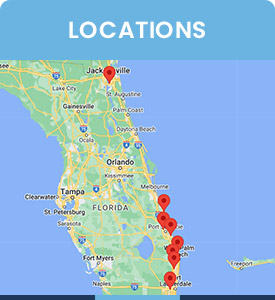Seasonal Affective Disorder (SAD) Treatment Q&A
Do you experience depression during the gray winter months? Perhaps you suffer from seasonal depression, sometimes referred to as seasonal affective disorder or SAD. Depression has several forms, one of which is seasonal affective disorder (SAD). It occurs in specific seasons of the year, usually in the fall or winter. For more information, contact us today or book an appointment online. We have convenient locations to serve you in Jacksonville, Boynton Beach, Palm Beach Gardens, Stuart, Royal Palm Beach, Port St. Lucie, Melbourne, Fort Lauderdale, and Jupiter, FL.


Table of Contents:
What is the meaning of seasonal affective disorder?
What are the symptoms of seasonal affective disorder?
What is the best way to deal with SAD?
How long does SAD last?
Seasonal affective disorder (SAD) affects around 1 in 20 Americans who reside in the northern half of the country, and is more prevalent among young adults, specifically those assigned female at birth, and is more likely to affect those with a family history of SAD.
Seasonal affective disorder (SAD) refers to the development of symptoms of depression due to a lack of sunlight during the day, often occurring in the fall and winter as the days become shorter and the body’s internal clock (circadian rhythm) is disrupted. The shortened days and lack of sunlight can cause a chemical change in the brain that results in symptoms of depression. Serotonin levels can decrease during periods of less sunlight, directly affecting an individual’s mood and playing a role in SAD, as with the changes that occur during fall or winter on melatonin levels that can affect the mood and sleep patterns of individuals with SAD. While it is more common to experience seasonal affective disorder during the fall or winter, even just the disruption to the circadian rhythm that occurs during the spring or summer can be enough to trigger SAD.
The symptoms that are commonly experienced with seasonal affective disorder will typically first appear as fairly mild, gradually worsening or becoming more severe as the seasonal changes progress, with most people with seasonal affective disorder finding that their symptoms appear in the fall and continue to worsen into the winter. Common symptoms that are experienced with SAD include:
• Daily feelings of general sadness or listlessness
• Decreased energy
• Sleeping longer than normal
• Increased difficulty concentrating
• Decreased interest in previously enjoyed activities
• Increased cravings for carbohydrates, leading to overeating and weight gain
• Suicidal thoughts
These symptoms tend to be more common among those with seasonal affective disorder that worsens in fall and winter, also known as winter-onset SAD, but will differ a bit for those with summer-onset SAD, such as:
• Insomnia or increased difficulty sleeping
• Loss of appetite often leads to weight loss
• Feelings of anxiety, agitation, or irritability
There are a few different management options available that individuals with seasonal affective disorder can use to minimize their symptoms as much as possible, including making sure to incorporate more mood-bosting activities into their result routines, such as connecting with loved ones or doing activities that they enjoy. It is also often recommended that individuals start to ensure that these activities become a part of their routine before the symptoms start to worsen, preparing a month or so in advance to ensure that the habits are already in place before the depressive symptoms have fully taken effect. This means that those with winter-onset depression are typically recommended to start to integrate mood-bosting activities in early to mid-fall to have a good routine figured out by the time winter sets in. Other methods of symptom management for SAD include:
• Bright light therapy
• Antidepressants
• Regular exercise and a balanced diet
• Vitamin D supplements
It is also recommended that those with SAD take advantage of any sunny days, with experts encouraging patients to go outside as much as possible when there are sunnier days, even if you have to bundle up to brave the cold weather.
The exact symptoms of seasonal depressive disorder will vary from patient to patient but will often last for around 4 to 5 months annually. It is also common for the symptoms to initially be quite mild, gradually worsening as time continues until there is a significant change in weather and longevity of daily sunlight. For those with winter-onset depression, the symptoms will typically develop in October, becoming noticeably worse around daylight saving time to lead to a continuous decline into November and December, with January and February often being when the worst symptoms are in effect.
This timeline will also vary depending on where you live, with those located in the northern states being at an increased risk for seasonal affective disorder, and the shorter the days where you live, the more you will likely be at risk of developing symptoms. For more information, contact us today or book an appointment online. We serve patients from Boynton Beach FL, Delray Beach FL, Palm Beach Gardens FL, Jupiter FL, Stuart FL, Palm City FL, Royal Palm Beach FL, Wellington FL, Citrus Ridge FL, Jacksonville FL, Riverside FL, Port St. Lucie FL, Beau Rivage West FL, Melbourne FL, Palm Bay FL, Fort Lauderdale FL, Hollywood FL, Jupiter FL, North Palm Beach FL, and surrounding areas.
Check Out Our 5 Star Reviews



Additional Services You May Need
▸ Mental Wellness
▸ Relationship Coaching
▸ Depression and Mood Disorders
▸ Women’s Health
▸ Panic Disorder
▸ Medications Management
▸ Men’s Health
▸ Individual Psychotherapy
▸ Bipolar
▸ ADHD
▸ Geriatric Mental Health
▸ Couple’s Counseling
▸ Obsessive Compulsive Disorder
▸ Social Phobia Treatment
▸ Eating Disorders
▸ Post Traumatic Stress Disorder
▸ Psychotic Disorders


